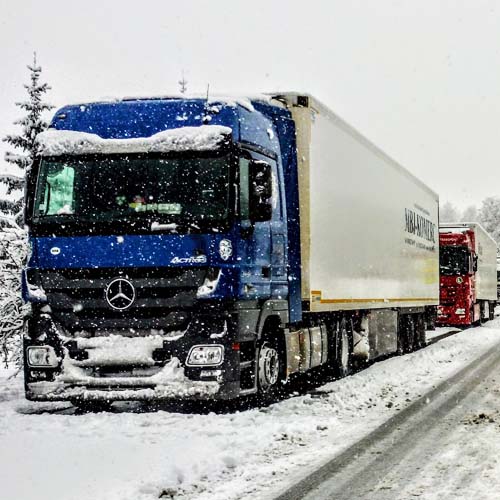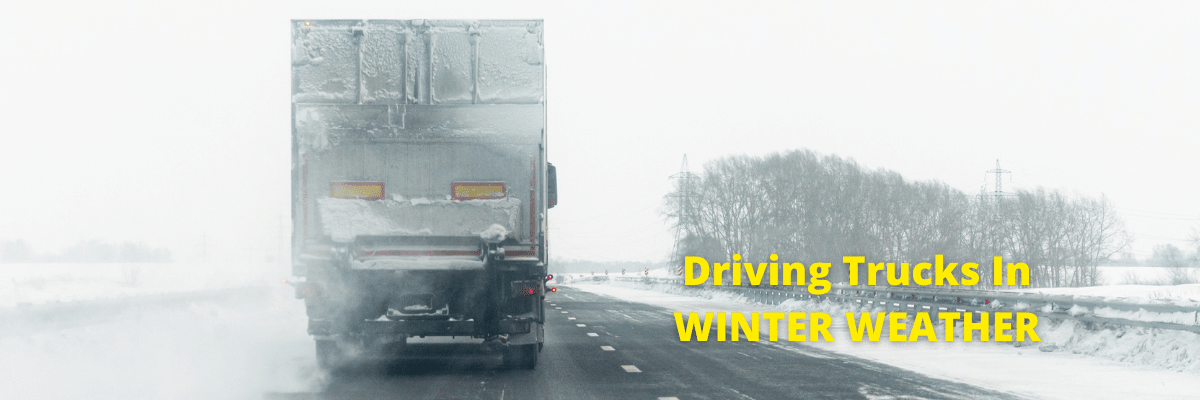Tips for safer truck journeys
In adverse weather the hazards associated with Driving Trucks in Winter weather increase greatly.
In winter especially, darker, shorter days and bad weather such as rain, hail, fog or snow reduce visibility.
High winds, ice, and slush can make vehicle control more difficult.
Winter sun tends to be low and can cause glare.
Employers should review their company’s driving risk management policy to ensure driving in adverse weather is properly covered.
What employers should consider for employees driving trucks in winter weather
- Is driving in adverse weather conditions considered?
- Who is responsible for telling employees what is expected of them?
- Are appropriate systems in place for employees who have to drive in adverse weather conditions?
- Do employees know how to handle vehicles in adverse weather conditions?
- Are employees familiar with the vehicle manual and any specific advice provided for driving in poor weather conditions?
- Do you need to consider providing additional driver training for those who drive your vehicles?
- Is there a plan in place for employees in the event of emergencies such as a collision, breakdown, or getting stuck or stranded in snow?
What truck drivers should consider before driving trucks in winter weather
Snow Shovel
No products found.
Where possible in adverse weather conditions:
Limit travel as far as possible to essential journeys only ask yourself is this trip really necessary?
For those with no option but to drive in difficult conditions:
Listen to weather forecasts, travel bulletins, and any advice issued by a Road Safety Authority.
Plan your journey, stick to major routes where possible.

Change or delay your journey as appropriate.
Allow extra time for your journey.
Inform someone such as your employer, manager, or supervisor where you are going and your estimated arrival time so that an alarm can be raised if you fail to arrive.
Turn your lights on to ensure that your vehicle is visible to other road users.
Fill your washer bottle with windscreen wash, The concentration used should be appropriate for the weather conditions.
Reduce your speed and drive according to the road and weather conditions, maintain greater stopping distances.
Wear sunglasses if the sun is low.
Avoid harsh braking or acceleration.
Carry out any maneuvers slowly and carefully.
Never feel pressurized to complete a journey if weather conditions are too dangerous.
Ensure that your vehicle is in a roadworthy condition prior to driving.
Items to check on your vehicle:
Tyres are in good condition and inflated to the correct pressure including the spare.
The vehicle has plenty of fuel.
Wipers, defrosters, and lights are in good working order.
An ice-scraper or de-icer is available for ice or snow.
- Deluxe Car Safety Kit for Winter Driving designed to keep you safe this winter
- Themal blanket, mini shovel, de-icer spray, instant hand warmers,
- Wind-up torch, high visibility vest, long life food, long life drinking water, foil blankets,
- First aid kit, emergency light sticks, signal whistle and ice scraper
- Emergency Kit backpack in Bright Red with Photoluminescent Writing
Last update on 2024-04-25 / Affiliate links / Images from Amazon Product Advertising API
Carry an emergency kit in your vehicle containing items such as:
A torch with extra batteries.
High visibility, reflective jacket, or vest in the vehicle cab so that you can put it on before you leave the vehicle.
A mobile phone for use only when parked.
An emergency warning triangle.
In cases where travel is unavoidable consider carrying items such as:
Food and a warm drink in a flask.
Warm clothing including a hat, gloves, and a warm blanket or sleeping bag.
Waterproof Boots to protect your feet.
Shovel and material for providing wheel traction if driving on soft ground or snow such as chains, old carpet, sand, gravel, cat litter, or salt.
Thank you for reading this article “Driving Trucks in Winter weather” if you would like to leave a comment on your views please do so below.





